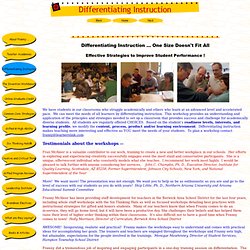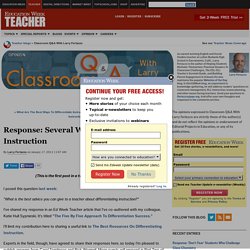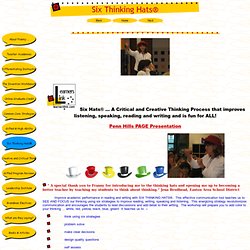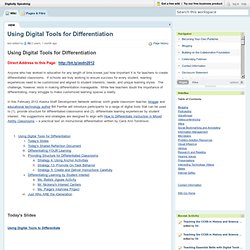

Differentiating Instruction. Differentiating Instruction ...

One Size Doesn't Fit All Effective Strategies to Improve Student Performance ! We have students in our classrooms who struggle academically and others who learn at an advanced level and accelerated pace. We can meet the needs of all learners by differentiating instruction. This workshop provides an understanding and application of the principles and strategies needed to set up a classroom that provides success and challenge for academically diverse students. Testimonials about the workshops -- Fran McAleer is a valuable contributor to our work, training to create a new and better workplace in our schools. More! Franny McAleer has been providing staff development for teachers in the Berwick Area School District for the last four years, including whole staff workshops with the Six Thinking Hats as well as focused workshops detailing best practices with instructional strategies for gifted and honors students.
AWESOME! Franny McAleer is a dynamic presenter. Dare to Differentiate - 50 Terrific Teacher Tips! Ways To Differentiate Instruction - Classroom Q&A With Larry Ferlazzo. (This is the first post in a two-part series on differentiation) I posed this question last week: "What is the best advice you can give to a teacher about differentiating instruction?

" I've shared my response in an Ed Week Teacher article that I've co-authored with my colleague, Katie Hull Sypnieski. It's titled "The Five By Five Approach To Differentiation Success. " I'll limit my contribution here to sharing a useful link to The Best Resources On Differentiating Instruction. Experts in the field, though, have agreed to share their responses here, so today I'm pleased to publish answers from Carol Tomlinson and Rick Wormeli.
Response From Carol Tomlinson Carol Tomlinson is an internationally-recognized leader and author in the field of differentiated instruction. My journey with differentiation began in my middle school classroom when it was quite clear that my one-size-fits-all approach to teaching was, in fact, not fitting many of my students. There were many more questions, of course. Differentiation - tools, tips and resources. Differentiation is an important aspect of education.

Students learn differently, have different needs, different backgrounds, different skills, different ability levels, different interests and more. As educators, we try to create engaging lesson activities that provide a variety of learning experiences and allow students to demonstrate their learning in different ways. Differentiation should occur in both how students learn and gain knowledge and skills, and in how they demonstrate and are assessed on what they have learned. “In the practice of education, differentiation is defined as working to address the abilities, interests, and needs (both perceived and real) of individuals.
Differentiation provides students with opportunities to approach curriculum from their strengths, as varied as these might be.” Here are some resources, tips, and tools on differentiation: Differentiation. Digital Differentiation. Technology is a tool that can be used to help teachers facilitate learning experiences that address the diverse learning needs of all students and help them develop 21st Century Skills.

At it's most basic level, digital tools can be used to help students find, understand and use information. When combined with student-driven learning experiences fueled by Essential Questions offering flexible learning paths, it can be the ticket to success. Here is a closer look at three components of effectively using technology as a tool for digital differentiation. Note: The interactive graphics you see below have been updated. They can be found in a newer post on this blog. Six Thinking Hats® Six Hats® ...

A Critical and Creative Thinking Process that improves listening, speaking, reading and writing and is fun for ALL! Penn Hills PAGE Presentation " A special thank you to Franny for introducing me to the thinking hats and opening me up to becoming a better teacher by teaching my students to think about thinking. " Jena Brodhead, Easton Area School District Improve academic performance in reading and writing with SIX THINKING HATS®. Think using six strategies problem solve make clear decisions design quality questions self assess collaborate more effectively The Research -- "Develop Critical and Creative Thinking Skills: Put on Six Thinking Hats®," PA Educational Leadership. Are You Left or Right Brain? Ways To Differentiate Instruction - Classroom Q&A With Larry Ferlazzo. The Best Resources On Differentiating Instruction.
My colleague Katie Hull-Sypnieski is leading a February 1st Education Week Webinar on differentiating instruction, and I would strongly encourage people to participate.

Katie’s the best teacher I’ve ever seen…. In addition, Katie and I have co-authored a piece for Education Week Teacher on the topic that will be appearing there soon (it’s appeared: The Five By Five Approach To Differentiation Success), and an upcoming post in my blog there will be talking about it, too (that two part series has also appeared). I also did a second two-part series in Ed Week on differentiation. Also, check out The Best “Fair Isn’t Equal” Visualizations. Given all that, a “The Best…” post was inevitable, and here it is. Daretodifferentiate - home. Using Digital Tools for Differentiation. Direct Address to this Page: Anyone who has worked in education for any length of time knows just how important it is for teachers to create differentiated classrooms.

If schools are truly working to ensure success for every student, learning experiences need to be customized and aligned to student interests, needs, and unique learning styles. The challenge, however, rests in making differentiation manageable. While few teachers doubt the importance of differentiating, many struggle to make customized learning spaces a reality. In this February 2012 Alaska Staff Development Network webinar, sixth grade classroom teacher, blogger and educational technology author Bill Ferriter will introduce participants to a range of digital tools that can be used to (1). provide structure for differentiated classrooms and (2). differentiate learning experiences by student interest.
Today's Slides Today's Shared Reflection Document To access our shared written reflection document, click here. She writes: Tomlinson - Differentiation Central. Differentiating Instruction. Workshop 7. You will see that the Reference Grid contains four columns.

Look carefully at the headings. The first column contains general information about dyslexic learners. It describes learning difficulties which dyslexic learners commonly experience to a greater or lesser degree. Of course, all learners are different, so this Reference Grid deals only in generalities. A better grid would be one which described the characteristics of the particular learner who is causing you concern, but this will come later. Without information of sort contained in Column 1, it is impossible to differentiate effectively the tasks we plan to set, yet it is rare for this information to be readily available to subject teachers.
The second column takes each of the points covered in the first column and suggests what impact that particular characteristic is likely to have on the dyslexic learner's efforts to manage in the foreign anguage classroom. The last column has several functions. Differentiating the curriculum. The Policy and implementation strategies for the education of gifted and talented students: Support package: Curriculum differentiation (2004) (pdf 1345kb) provides an introduction to curriculum differentiation for gifted and talented students and is suitable for all stages of schooling. It needs to be read in conjunction with the Policy and implementation strategies for the education of gifted and talented students (revised 2004) and its companion document (2004) (pdf 270kb). The purpose of differentiating the curriculum is to provide appropriate learning opportunities for gifted and talented students.
Three important characteristics of gifted students that underscore the rationale for curriculum differentiation (Van Tassel–Baska, 1988) are the capacity to: learn at faster rates find, solve and act on problems more readily manipulate abstract ideas and make connections. The creation of a differentiated curriculum requires some pre-planning.
Definitions Article. Web English Teacher.